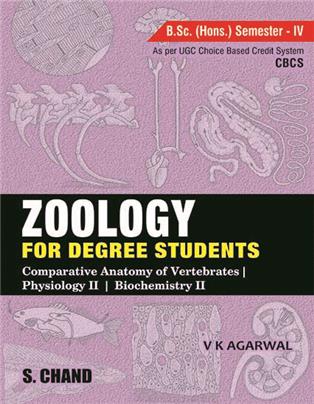
Author : Dr. V K Agarwal
Price : 650.00 520.00
This textbook has been designed to meet the needs of B.Sc. (Hons.) Fourth Semester students of Zoology as per the UGC Choice Based Credit System (CBCS). Comprehensively written, it explains the essential principles, processes and methodology of Comparative Anatomy of Vertebrates, Animal Physiology: Life Sustaining Systems and Biochemistry of Metabolic Processes. This textbook is profusely illustrated with over 550 well-labelled diagrams, not only to supplement the descriptions, but also for sound understanding of the concepts.
CC VIII: COMPARATIVE ANATOMY OF VERTEBRATES
1. Definition, Historical Background and Concepts of Comparative Vertebrate Anatomy
2. Integumentary System
3. Skeletal System
4. Digestive System (Alimentary Canal, Associated Glands and Dentition)
5. Respiratory System
6. Circulatory System
7. Urinogenital System
8. Nervous System
9. Sense Organs
CC IX: ANIMAL PHYSIOLOGY-LIFE SUSTAINING SYSTEMS
1. Definition, History and Branches of Physiology
2. Physiology of Digestion
3. Physiology of Respiration
4. Renal Physiology (Excretion)
5. Osmoregulation and Regulation of Acid-Base Balance
6. Blood
7. Physiology of Heart
CC X: BIOCHEMISTRY OF METABOLIC PROCESSES
1. Overview of Metabolism
2. Carbohydrate Metabolism
3. Lipid Metabolism
4. Protein Metabolism
5. Oxidative Phosphorylation
INDEX
Be the first one to review
Your email address will not be published.
Your rating for this book :
S Chand And Company Limited
Building No. D-92, Fifth Floor,
Sector – 02, Noida 201301,
Uttar Pradesh (India)
1800 1031 926